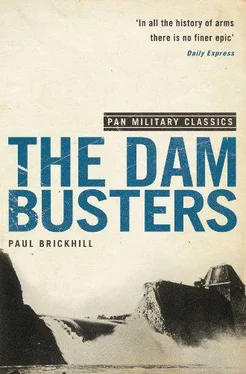Oil! Rumanian oil fields were too far for existing bombers, but a possibility for a future bomber. Germany’s synthetic refineries were massive and well defended; perhaps a target for bigger bombers.
Dams! Three German dams stood out—the Moehne, the Eder and the Sorpe. All in the Ruhr, they accounted for nearly all the water supply to that monstrous arsenal. Wallis knew that the German method needed eight tons of water to produce a ton of steel. The possibilities were intriguing.
The Moehne dammed Moehne Lake where the Heve flowed into the Ruhr River, maintaining the level so that barges with coal and steel and tanks could go to and from the foundries. Moehne Lake held 134 million tons of water. The Eder dammed the Eder River in Eder Lake, 212 million tons of water. It controlled the level of Germany’s second most important waterway, the Mittelland Canal. Even Kassel, forty miles away, got its water from the Eder. The Sorpe dammed another tributary of the Ruhr River in Sorpe Lake.
The Moehne was 112 feet thick at the base, 130 feet high and 25 feet thick at the top where a roadway ran; the Eder was even bigger. Wallis acknowledged that they were formidable. A 500-lb. bomb would hardly scratch the concrete. No less formidable the Sorpe, an earth dam, two sloping mounds of earth sealed and buttressed in the centre by a core of concrete.
In an engineering library Wallis unearthed accounts of their construction compiled by the proud engineers who had built them and found it hard to discipline his excitement as he read what the effects of breaching the dams could be.
It would not merely destroy hydro-electric power and deprive foundries of essential water, but affect other war factories which needed water for their processes. Disrupting them might cause a dozen critical bottlenecks in the completion of tanks, locomotives, guns, aircraft—almost anything one cared to name. It would deprive the populace of water too, which was no cause for joy in a gentle soul like Wallis but would at least induce in them a lessening of zest for the war.
There was still more to it. Breaches in the dams would send enormous floods ripping down the valleys, tearing away roads, bridges and railway lines, smashing factories and houses, so that some factories, rather than be deprived of water, would receive somewhat too much.
All this was fine, Wallis thought… logical ideas; but again one big flaw. The dams were so colossal that bombs twenty times bigger than existing ones were not going to hurt them.
His figures showed that when a 1,000-pounder exploded the charge expanded as a gas bubble, but at the end the bubble was only 20 feet across. A lot of damage was done beyond this 10-foot radius, however, by flying fragments, by blast and by the pressure pulse, or “shock wave.” Wallis well remembered the pedantic description of Shockwaves… “there is no motion of the transmitting medium other than the usual oscillation of particles to and fro about their position of rest as the wave passes through them.” Thin air gave scope to flying fragments and blast but the shock wave soon dissipated.
It would vibrate a structure, but not enough. To be destructive, shock waves had to travel through a more solid medium than air. And somewhere in Wallis’s brain a little cell awoke and stirred restlessly, an old memory, locked up and almost forgotten. He felt there was something he knew about shock waves that he should remember, tried to think what it was—it was a long time ago—but the harder he tried the farther it receded. It was only when he put it out of his mind that it sneaked insidiously back to him again.
It was something he had read, something about concrete. And then it hit him. Waterloo Bridge! Concrete piles being driven into the bed of the Thames! That was years ago. The piles had kept shattering mysteriously and there had been an investigation. He started searching his bookcases and in a quarter of an hour had found it, an article in a 1935 journal of the Institution of Civil Engineers. The great drop-hammers had been slamming the piles into the river-bed and the tops of the piles had been exploding upwards.
Investigation narrowed the cause to the shock waves. The sudden blows sent shock waves shivering down the piles; at the bottom they met the blunt resistance of the clay and bounced back up the pile at something like 15,000 feet a second, reaching the top just after the hammer had bounced off, so there was nothing to rebound from again and they passed out and away, and in their wake you got a tension after the compression. A sort of crush and then a sharp stretch, almost in the same moment; enough to make a structure split—to shatter it.
Concrete, the article concluded sagely, well resisted compression but poorly withstood tension. Wallis docketed the fact in his mind, thinking of dams.
You needed a solid medium to get destructive shock waves!
Of course, if you could bury a bomb deep in… But you couldn’t slice a big bomb into ferro-concrete. No, but you might be able to inject it deep into some less solid medium before it exploded. You’d get the shock waves then. The expanding gas effects would be greater too; tamped by the encircling solids they would have to burst their way out.
He was aware that bombs and shells often buried themselves 3 or 4 feet in the ground before exploding, but that was so shallow the explosion forced its way easily to the top, causing a small crater, and the shock waves dissipated into the air. It was less effective than a surface explosion because the blast and shock waves went straight up instead of outwards.
But if you could lock the explosion underground so it could not break out you would get a sort of seismic disturbance… an earthquake! An earthquake bomb!
The idea shaped in his mind while he was sitting in a deep chair in his home at Emngham, an unspectacular setting for the birth of something so powerful.
But how to sink a bomb deeply into a resisting medium? You could not put one deep into a concrete dam. But a dam is set in water!
Water! It might not transmit a shock wave as well as earth but it would do so better than air. The tamping effect of water would produce a concentrated explosion and carry the “shock “punch. Wallis was starting to feel he might be getting somewhere.
And how about sinking the bomb in earth? A schoolboy knew the two principles. The heavier the bomb, the more power and speed it developed in falling. Wallis had learned the classic example in school. Drop a mouse down a well and at the bottom it will be able to get up and run. Drop a horse down and the horse will, probably burst. Because it was heavier it would hit harder. And the farther it fell, the faster it would fall!
So there it was: a bomb as heavy as possible (and as slim as possible) dropped from as high as possible.
Wallis looked up more books, studied the propagation of shock waves in soil, the effects of underground explosions at depth, and even found pages on the penetrative powers into soils of shells and light bombs. There was a piece about an enormous land mine exploded under a German-held hill at Messines Ridge in World War I. A colossal charge sent shock waves ripping into the earth, the hill was destroyed and the shock was felt in Cassell—30 miles away.
Wallis pulled out a pad and pencil and worked for a week, covering sheets with calculations, equations, formulas—and came up with a preliminary theoretical answer. A 10-ton bomb, with 7 tons of explosive in an aerodynamically-designed case of special steel, dropped from 40,000 feet, would reach a speed of 1,440 feet per second, or 982 m.p.h.—well over the speed of sound. At that rate it should penetrate an average soil to a depth of 135 feet.
A charge of that size should theoretically “camouflet” (not break the surface) at a depth of 130 feet. What it would do was cause a violent earthquake movement on the surface resulting in a hump forming.
Читать дальше












